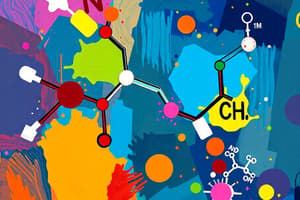Podcast
Questions and Answers
What is the key structural difference between phenols and alcohols?
What is the key structural difference between phenols and alcohols?
- Phenols have the hydroxyl group attached directly to an aromatic ring, while alcohols have the hydroxyl group attached to an aliphatic moiety. (correct)
- Phenols have the hydroxyl group attached to an aliphatic moiety, while alcohols have the hydroxyl group attached to an aromatic ring.
- Phenols have a nitro group on the aromatic ring, while alcohols do not.
- Phenols have a double bond in the aromatic ring, while alcohols do not.
Which of the following best explains why phenols are more acidic than alcohols?
Which of the following best explains why phenols are more acidic than alcohols?
- Phenols have a stronger intermolecular hydrogen bonding than alcohols.
- Phenols have a higher boiling point than alcohols.
- The phenoxide anion formed from phenols is stabilized by resonance, while the alkoxide anion formed from alcohols is not. (correct)
- Phenols have a longer carbon chain than alcohols.
Which of the following factors would increase the acidity of a phenol?
Which of the following factors would increase the acidity of a phenol?
- Increasing the length of the alkyl substituent on the aromatic ring.
- Increasing the number of hydroxyl groups on the aromatic ring.
- The presence of an electron-donating group on the aromatic ring.
- The presence of an electron-withdrawing group on the aromatic ring. (correct)
What is the IUPAC name for the compound $\beta$-naphthol?
What is the IUPAC name for the compound $\beta$-naphthol?
Which of the following is the correct IUPAC name for the compound 2-Bromo-5-ethylphenol?
Which of the following is the correct IUPAC name for the compound 2-Bromo-5-ethylphenol?
Which of the following reactions is used to synthesize phenols from benzene?
Which of the following reactions is used to synthesize phenols from benzene?
What is the primary electronic effect of the hydroxyl (OH) group on the benzene ring?
What is the primary electronic effect of the hydroxyl (OH) group on the benzene ring?
Which of the following is the most important factor in determining whether a substituent will be an activator or deactivator in electrophilic aromatic substitution (EAS) reactions?
Which of the following is the most important factor in determining whether a substituent will be an activator or deactivator in electrophilic aromatic substitution (EAS) reactions?
Why is the use of a Lewis acid catalyst critical in electrophilic aromatic substitution (EAS) reactions on benzene?
Why is the use of a Lewis acid catalyst critical in electrophilic aromatic substitution (EAS) reactions on benzene?
Which of the following is the primary reason why the hydroxyl (OH) group is considered a strong activator in electrophilic aromatic substitution (EAS) reactions?
Which of the following is the primary reason why the hydroxyl (OH) group is considered a strong activator in electrophilic aromatic substitution (EAS) reactions?
What is the primary electronic effect of the methoxy (OCH3) group on the benzene ring in electrophilic aromatic substitution (EAS) reactions?
What is the primary electronic effect of the methoxy (OCH3) group on the benzene ring in electrophilic aromatic substitution (EAS) reactions?
Flashcards are hidden until you start studying
Study Notes
Phenols and Alcohols
- The key structural difference between phenols and alcohols is that phenols have an OH group directly attached to a benzene ring, whereas alcohols have an OH group attached to a saturated carbon atom.
Acidity of Phenols
- Phenols are more acidic than alcohols due to the resonance stabilization of the phenoxide ion, which allows the negative charge to be delocalized around the benzene ring.
- Factors that increase the acidity of a phenol include the presence of electron-withdrawing groups ortho or para to the OH group, and the planarity of the phenol molecule.
Nomenclature of Phenols
- The IUPAC name for the compound β-naphthol is 2-naphthol.
- The correct IUPAC name for the compound 2-Bromo-5-ethylphenol is 2-bromo-5-ethylphenol.
Synthesis of Phenols
- One method for synthesizing phenols from benzene is through the Dow process, which involves the reaction of benzene with sulfuric acid and nitric acid.
Electronic Effects in EAS Reactions
- The primary electronic effect of the hydroxyl (OH) group on the benzene ring is that it is a strong activator, which means it increases the rate of electrophilic aromatic substitution (EAS) reactions.
- The primary electronic effect of the methoxy (OCH3) group on the benzene ring in EAS reactions is that it is an activator, although weaker than the OH group.
- The most important factor in determining whether a substituent will be an activator or deactivator in EAS reactions is its ability to donate or withdraw electrons from the benzene ring.
Lewis Acid Catalysis in EAS Reactions
- The use of a Lewis acid catalyst is critical in EAS reactions on benzene because it helps to generate a highly electrophilic species that can efficiently react with the aromatic ring.
- The primary reason why the hydroxyl (OH) group is considered a strong activator in EAS reactions is that it is able to donate electrons to the benzene ring, making it more prone to electrophilic attack.
Studying That Suits You
Use AI to generate personalized quizzes and flashcards to suit your learning preferences.




